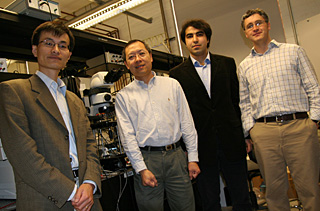Down to the Wire
 L to R: Peidong Yang, Ming Wu, Arash Jamshidi, Peter J. Pauzauskie. (Photo by Ming Wu.)For years, nanoengineers have known how to create tiny wire transistors, sensors, light emitters and other useful components, but there’s been no sure way to assemble them into integrated circuits because they’re too small to manipulate. And so a world of potential capabilities and knowledge remained tantalizingly out of reach. “You could look at things under a microscope, but you couldn’t touch them,” explains EECS professor Ming Wu. “You couldn’t even move something out of the way.”
L to R: Peidong Yang, Ming Wu, Arash Jamshidi, Peter J. Pauzauskie. (Photo by Ming Wu.)For years, nanoengineers have known how to create tiny wire transistors, sensors, light emitters and other useful components, but there’s been no sure way to assemble them into integrated circuits because they’re too small to manipulate. And so a world of potential capabilities and knowledge remained tantalizingly out of reach. “You could look at things under a microscope, but you couldn’t touch them,” explains EECS professor Ming Wu. “You couldn’t even move something out of the way.”
But Wu, chemistry professor Peidong Yang and their students Arash Jamshidi and Peter J. Pauzauskie have developed “optoelectronic tweezers” that can individually address wires and other nanoscale objects and convey them to precise locations. According to Yang, this has been the field’s most challenging problem. Solving it paves the way for an entire class of devices from microdisplays to medical imaging tools.
In the tweezers process, technically known as light-induced dielectrophoresis or LIDEP, the nano-sized objects sit in a pool of liquid above a silicon-coated plate, surrounded by an alternating electric field. When a tiny laser beam strikes the silicon, it generates a local resistance change in that spot, the same way a solar cell turns light into electricity. This deforms the electric field and produces a force that pulls the wires towards the light pattern. Move the light beam, and the force follows, carrying the objects along with it.
This process improves upon an older laser-only technique that won’t work with the smallest metallic particles because it heats them up and vaporizes them, “similar to aluminum foil in the microwave,” Pauzauskie explains. Because the optoelectronic tweezers technique is gentler, it can handle a far wider range of materials, including delicate, chemical-sensing silver nanothreads that could be used as electronic noses and other devices.
The team is also exploring how the tweezers work with carbon nanotubes, single-molecule structures with the potential to make computer chips far more powerful than etched silicon. There are two types of nanotubes with different electrical characteristics–metallic and semiconducting–but they can only be produced together. The tweezers might be able to sort the tubes based on the different forces they exert on each type. “We won’t be able to build large scale and effective electronics out of carbon nanotubes until we can separate the metallic ones from semiconducting ones,” Jamshidi explains. “And accomplishing this can have a large impact on nanoelectronics.”
To hold the circuits in place, Wu and his team arrange the nanowires in hydrogel liquid, which they then expose to UV light. This hardens the gel, encasing the circuit in a solid and durable medium. Ultimately, the tweezers could work in systems that sort components and mass-produce nanocircuits automatically.
As with any breakthrough tool, we can’t predict all the possible uses for the tweezers, but one promising area Wu envisions is displays. Arrays of light-emitting nanowires could make lightweight, low-power microdisplays that could comfortably accommodate heads-up displays and virtual reality in eyeglasses, without bulky goggles. Nanowires could also be woven into broad, flexible materials to make durable and potentially ubiquitous displays with resolutions indistinguishable from reality.
In the life sciences, the tweezers might be used in the future to manipulate strands of DNA. Already, nanowires held by the new optoelectronic tweezers work as extraordinarily detailed chemical probes, amplifying the signal from Raman spectroscopy and increasing its resolution down to the nanowire’s own width. As a result, our chemical maps of objects like cell surfaces can now be drawn in far greater detail. Both Wu and Yang will be using this technique, under a grant from the National Institutes of Health, to look at how cell membranes respond to cancer. As Wu explains, “For the first time, we’ll be able to observe how cells respond to medicines at the molecular level.”
P. James Schuck, Aaron T. Ohta, Pei-Yu Chiou, and Jeffrey Chou also contributed to the original research described in this article.
